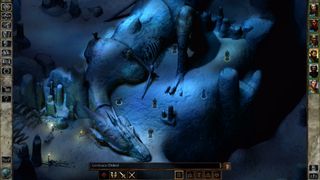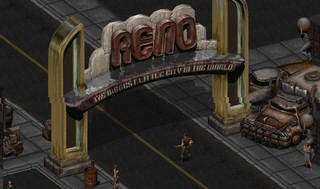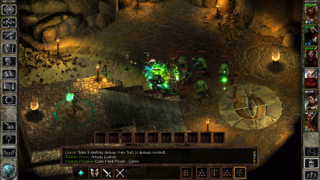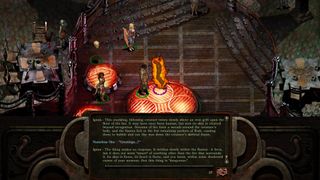How Black Isle became a legend
CRPGs wouldn't be the same without its trips into post-apocalyptic California and the Forgotten Realms.

This article first appeared in PC Gamer magazine issue 363 in November 2021, as part of our 'DNA Tracing' series, where every month we delve into the lineages behind iconic games and studios.
The Black Isle isn't even an island, in reality. It's a peninsula in the Scottish Highlands, home to B&Bs and commuters working in nearby Inverness. Visitors frequent cottage museums and peer out across the damp beach, looking for bottlenose dolphins.
In the imaginations of Interplay's internal development team, however, Black Isle became a blasted rock in the middle of the ocean, illuminated by fierce lightning strikes—more akin to The Witcher's Aretuza than the real-life place accessible by the A9 trunk road.
Yet that's the spirit with which Black Isle Studios was founded—an enthusiasm for extrapolating mystery and adventure from a mundane world. It first did so with Fallout in 1997. Developed by '80s kids who had grown up under the perpetual threat of nuclear holocaust, it organically became a Californian vision of the postapocalypse—not so much The Golden State as a land baked until it cracked and bubbled. The stroke of genius, though, was to juxtapose that wasteland with imagery ripped straight from utopia—the perfect, picket-fence existence portrayed by '50s American advertising. The finished game dripped with irony right from character creation, where a Monopoly Man-esque mascot grinned winningly as he blew enemies into chunks.
It's easy to look back on mid-'90s Interplay as a haven for RPG development, but that's far from the truth. RPGs were out of fashion, and like almost any major publisher you could name today, Interplay was preoccupied by sports. But that worked out in Black Isle's favour: the executives were too distracted to question the designers of the low-budget RPG in the corner. By the time they paid close attention to Fallout, it was a surprise critical hit.
Infinity and Beyond

Sensing that they wouldn't get away with working quite the same way again, Fallout's central creative trio—Tim Cain, Jason Anderson, and Leonard Boyarsky—left to found Troika Games. These were not sequel people (though two of them, Cain and Boyarsky, would eventually rejoin Black Isle staff to work on The Outer Worlds, which came out in 2019, at Obsidian).
While Fallout 2 did get made, a deal made during the original game's development ensured that Black Isle's focus would shift elsewhere. Interplay had acquired the licence for D&D, at great expense—and after Black Isle boss Feargus Urquhart suggested BioWare make use of it, his team inherited the Infinity Engine built for Baldur's Gate. It would have been very easy for Black Isle to become BioWare's b-team—indeed, the two studios were confused throughout the late '90s by fans. But instead, the studio pushed the Infinity Engine to new extremes.
With Planescape: Torment, that meant forefronting the dialogue box. Where Bioware had used it only to relate conversation, Black Isle filled the space with prose that detailed the demeanour and dress of your acquaintances, fleshing out the basic sprites and giving the game a novelistic air you can still see in the likes of Disco Elysium. Moreover, Torment's developer built on Fallout's commitment to holding players accountable for their choices. It's funny to think that Black Isle's D&D debut constituted an existential crisis for the tabletop system, as the team picked apart its rules on moral alignment.
The biggest gaming news, reviews and hardware deals
Keep up to date with the most important stories and the best deals, as picked by the PC Gamer team.
Dale, Winter

Yet it was the same studio that captured classic D&D's breezy, freeing sense of adventure so completely in Icewind Dale. Now paring back the dialogue and leaning into combat, Black Isle exploited the Infinity Engine's potential for intricately designed battles. It created the thinking person's Diablo: a linear series of elaborate murder puzzles that took you deeper and deeper beneath the mountains made famous by Drizzt Do'Urden.
Since Icewind Dale gave you both a quicksave key and a pause button, it had no qualms about disassembling your grizzled party of killers in seconds. Some encounters forced you to step back, reconsider your strategy, and scour your spellbooks for counters. Your reward for getting it right was the sight of whole skeletal armies crumbling to pieces, as if somebody had pulled the bottom skull from a catacomb Jenga tower.
What little writing space Black Isle did allow itself over the course of the series was typically top-notch, rooting you deeply in the Dale—like the enormous oak tree that swaddles the hamlet of Kuldahar. Click on the kitchens of Icewind Dale 2's first pub and you'll be told that the "big, wheezing iron stove reminds you of the barkeep". Rarely have RPGs told their stories with such clarity.
Torn Apart

It wasn't all perfect—in an early pre-echo of Mass Effect 3's ending controversy, Black Isle put out a free Icewind Dale update to placate those who found its Heart of Winter expansion too abrupt. But the excellence of Black Isle's games is remarkable when you consider that Interplay was wracked by financial trouble throughout it's existence. Only in later years did that turbulence start to yield casualties: a new fantasy RPG called Torn was cancelled because "it was not going to be done in time to get Interplay the revenue the company needed to continue operations", as Urquhart told Gamespot.
Licensing quirks, meanwhile, saw a Forgotten Realms project called The Black Hound unexpectedly crowned Baldur's Gate 3—only for the game to be scrapped after Interplay lost the rights to use the Baldur's Gate brand on PC. In the years afterwards, Black Isle games only existed on console, in the form of the Dark Alliance series—less the thinking person's Diablo than simply Diablo, again.
Fittingly for a division that had dealt in liches and ghouls, Black Isle persisted after death, far exceeding its natural lifespan. It still technically exists today, though whether you recognise its legitimacy as the same studio that made Fallout is a matter for personal contemplation. Is Black Isle the person who operates the official Twitter account? Is it the group of people who went on to found Obsidian? Just ask yourself this: when the lightning strikes that dark rock, as it did in the famous splash screen, who does it illuminate?
Most Popular


